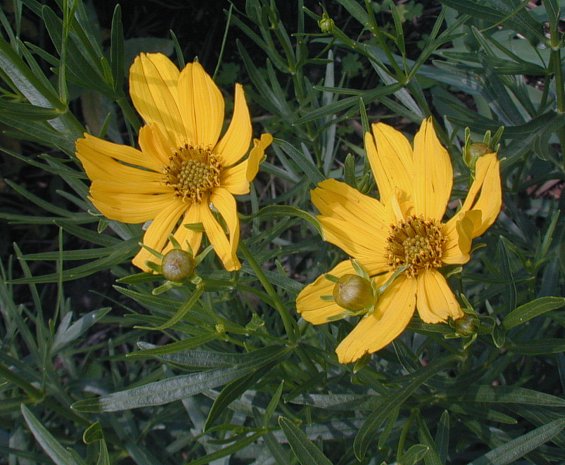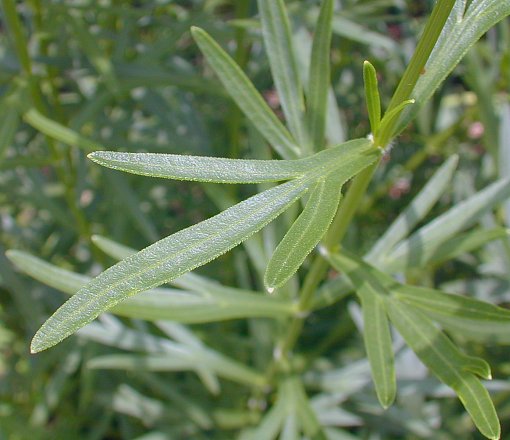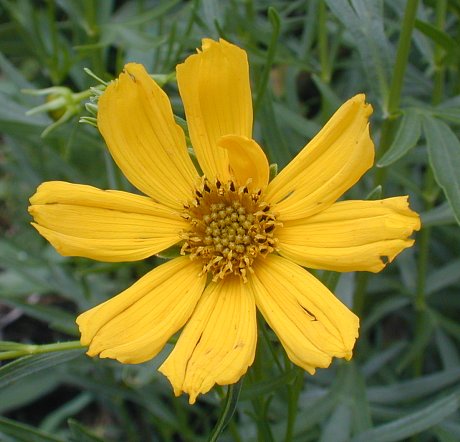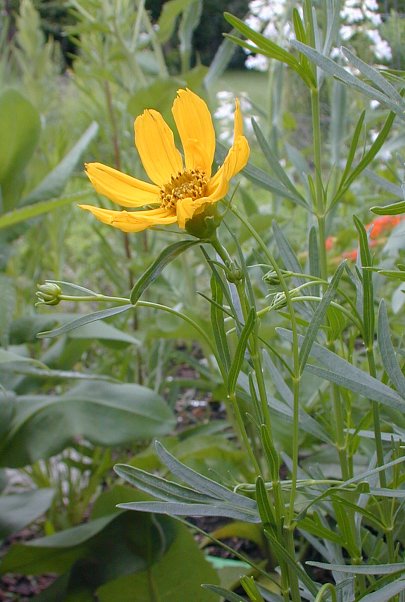Description: This perennial plant is 1–2½' tall and more or less erect. The central stem is unbranched below, while above it branches occasionally. The stems are medium green, terete, and mostly glabrous, except at the bases of leaves, where they have tufts of hair. Pairs of opposite sessile leaves are distributed evenly along the stems. Lobed leaves are 1-3" long and about one-half as much across (in outline), while unlobed leaves are up to 1" long and less than ¼" across; they are widely spreading to ascending. Each leaf is usually divided into 2 lateral lobes and a terminal lobe; some of the uppermost leaves and small axillary leaves lack lobes. Both lateral and terminal lobes are narrowly oblong in shape; the lateral lobes occur toward the middle of each leaf, where they diverge from each other at about a 60º angle. Both unlobed leaves and the bases of lobed leaves are narrowly oblong. The leaf margins are smooth (entire). Upper leaf surfaces are medium to dark green and glabrous, while lower leaf surfaces are medium green and glabrous. The upper stems terminate in either solitary or pairs of flowerheads (usually the former) on peduncles that are more or less erect and about ½–2" long. These peduncles are medium green, terete, and glabrous.

Each flowerhead spans about 1½–2" across, consisting of a dense head of numerous disk florets that are surrounded by about 8 ray florets. The tiny corollas of the disk florets are yellow, tubular in shape, and 4-5 lobed. The petaloid rays of the flowerheads are yellow, broadly oblong in shape, and somewhat truncate and ragged along their tips. Surrounding the base of each flowerhead, there are about 8 appressed phyllaries (inner floral bracts) in a single series; these phyllaries are yellowish green, broadly ovate in shape, and about 8 mm. long. Slightly below the base of each flowerhead, there are about 8 outer bracts that are ascending to erect; these outer bracts are green, glabrous, narrowly oblong in shape, and 8-12 mm. long. The blooming period occurs during early summer, lasting about 3 weeks. There is no noticeable floral scent. Afterwards, the florets are replaced by achenes. These achenes are about 5 mm. long, brown or grayish brown, oblong to elliptic-oblong in shape, slightly concave-convex, longitudinally and finely ridged, and hairless; the apices of these achenes are truncate, lacking hairs or significant scales. The root system is fibrous and long-rhizomatous, often forming colonies of clonal plants. During autumn, the deciduous foliage of this plant often acquires reddish tints.

Cultivation:
The preference is full sun, mesic to dry-mesic conditions, and
soil containing loam, clay-loam, sandy loam, or some gravel. This plant
is easy to cultivate. It may sprawl across the ground unless it
receives full sun and rather lean treatment with fertilizer and water.
While it can spread aggressively from its rhizomes, Prairie Coreopsis
is more impressive when it is allowed to form clonal colonies.
The foliage usually remains in good condition until hard
frost during the autumn.
Range & Habitat:
The native Prairie Coreopsis occurs occasionally in most counties of
Illinois, but it is rare or absent in SE Illinois and some western
counties (see Distribution
Map).
Habitats include well-drained black soil prairies, sand prairies,
gravel prairies, hill prairies, thickets, open areas of rocky upland
forests, savannas, limestone glades, and abandoned fields. Prairie
Coreopsis is usually found in high quality natural areas because the
dispersion of its seeds is rather limited and it is infrequently
cultivated.

Faunal Associations: The nectar and pollen of the flowerheads attract many kinds of insects because of their abundance and accessibility. These floral visitors include digger bees (Melissodes spp.), cuckoo bees (Epeolus spp., Nomada spp.), leaf-cutting bees (Megachile spp.), Halictid bees (including green metallic bees), dagger bees (Calliopsis spp., Heterosarus spp.), Sphecid wasps and other wasps, Syrphid flies (Eristalis spp. and others), bee flies (Exoprosopa spp. and others), thick-headed flies (Conopidae), Tachinid flies, bottle flies (Lucilia spp.), Muscid flies, butterflies, skippers, moths, and beetles (Robertson, 1929). A digger bee, Melissodes coreopsis, is an oligolege (specialist pollinator) of Coreopsis spp. Some insects feed destructively on the plant juices, flowerheads, and other parts of Prairie Coreopsis and other Coreopsis spp. These species include the Red-spotted Aster Mirid (Polymerus basalis), an aphid (Uroleucon reynoldense), the Ragweed Leaf Beetle (Calligrapha bidenticola) and Coreopsis Leaf Beetle (Calligrapha californica coreopsivora), and larvae of such moths as the Dimorphic Gray (Tornos scolopacinarius), Wavy-lined Emerald (Synchlora aerata), and Common Tan Wave (Pleuroprucha insulsaria). The larvae of the latter two moths feed on the flowerheads. See Knight (1941), Blackman & Eastop (2013), Clark et al. (2004), Wagner (2005), and Covell (1984/2005) for more information. Mammalian herbivores occasionally browse on the foliage of Coreopsis spp., including rabbits, groundhogs, deer, horses, and livestock.

Photographic
Location:
Photographs were taken at the webmaster's wildflower garden in Urbana,
Illinois.
Comments:
Among the many prairie wildflowers with showy yellow flowerheads,
Prairie Coreopsis (Coreopsis
palmata) has the advantage of flowering somewhat earlier
in the summer than most of them. It also blooms before the warm-season
prairie grasses develop rapidly in response to hot summer weather,
allowing its flowerheads to be seen from a distance by flower-visiting
insects. Prairie Coreopsis can be distinguished from Sand Coreopsis (Coreopsis lanceolata)
by its more deeply lobed and shorter leaves; these leaves are
distributed evenly along the stems, while the leaves of Sand Coreopsis
are more clustered toward the bottoms of the stems. In contrast,
the leaves of Prairie Coreopsis have wider lobes than the
leaves of Large-flowered Coreopsis (Coreopsis
grandiflora)
and Whorled Coreopsis (Coreopsis
verticillata). The leaves of these latter two species have
lobes that are thread-like, rather than finger-like. Finally, Prairie
Coreopsis is a much shorter plant that blooms earlier than Tall
Coreopsis (Coreopsis
tripteris). In addition, the deeply lobed leaves of this
latter species are much larger in size.